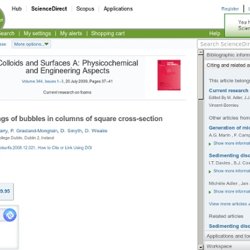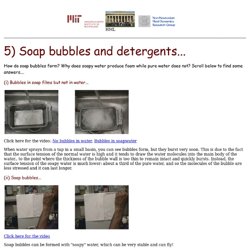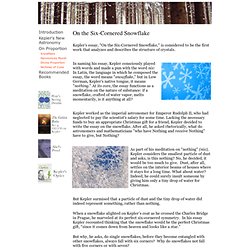

On the Genesis of Hexagonal Shapes. Colloids and Surfaces A: Physicochemical and Engineering Aspects - Ordered packings of bubbles in columns of square cross-section. Volume 344, Issues 1–3 , 20 July 2009, Pages 37–41 Current research on foams Edited By M.

Adler, J.J. Cilliers, O. Minster and S. School of Physics, Trinity College Dublin, Dublin 2, Ireland Received 9 October 2008 Revised 11 December 2008 Accepted 12 December 2008 Available online 24 December 2008 , How to Cite or Link Using DOI Abstract The introduction of bubbles of equal size into a confined space with dimensions comparable to the bubble diameter generally leads to the formation of ordered foam structures.
Keywords Foams ; Structure ; Simulation Figures and tables from this article: Fig. 2. The demonstration of conformal maps with two-dimensional foams - Abstract - European Journal of Physics. Soap bubbles, surfactants, detergents. 5) Soap bubbles and detergents...

How do soap bubbles form? Why does soapy water produce foam while pure water does not? Scroll below to find some answers.... (i) Bubbles in soap films but not in water... Click here for the video: No bubbles in water , Bubbles in soapwater When water sprays from a tap in a small basin, you can see bubbles form, but they burst very soon. (ii) Soap bubbles... Click here for the video Soap bubbles can be formed with "soapy" water, which can be very stable and can fly! (iii) Large soap bubbles... Δ p = p inside - p outside = (4γ ) / R As one passes across a curved surface or interface, a jump in pressure occurs given by above relationship. (iv) Foam Foam is created when the surface tension of water (attraction of surface molecules toward the center, which gives a drop of water its round shape) is reduced and air is mixed in, causing bubble formulation.
(v) Laplace Pressure As one passes across a curved surface or interface, a jump in pressure occurs. Patterns In Nature, an online book. Patterns And Physical Laws From Bubbles To Beehives "That which is not good for the bee-hive cannot be good for the bees.

"-- Marcus Aurelius You are viewing a draft of the book entitled "Patterns – The Art, Soul, and Science of Beholding Nature". The final version of this book has now being published as an Amazon Kindle eBook. There are some significant changes in the eBook that are not in this draft. Some of the ideas in the eBook are contained in posts at my Patterns In Nature Blog. In an attempt to synthesize and to simplify, much has been said about the idea that patterns in nature can be formed by simple physical laws. This page looks at physical laws and how they work with bee behavior to form the common hive pattern.
Of all the shapes in our geometric inventory, a sphere has the smallest surface area for a given volume. Stars, Bubbles and Beehives – Complexity Joined. In an attempt to synthesize and to simplify, much has been said about the idea that patterns in Nature can be described with simple physical laws.

This idea has appealed to mathematicians, physicists, and others who adhere to the reductionist world view. While it is true that physical laws play a very important part in pattern formation, they are only part of the story as the honey bee demonstrates. My story begins with the stars — complex dynamic systems where the hydrogen atom hangs out. Somehow, the complex system of two hydrogen atoms and one oxygen atom joined to produce water molecules and water drops — both hierarchies of complex systems.
Of all the shapes in our geometric inventory, a sphere has the smallest surface area for a given volume. Each water molecule interrelates with neighboring molecules by way of intermolecular forces that result in the molecules being attracted to each other. Foam is a collection of bubbles. But, what does all of this have to do with honeycombs? The Six Cornered Snowflake. On the Six-Cornered Snowflake Kepler's essay, "On the Six-Cornered Snowflake," is considered to be the first work that analyzes and describes the structure of crystals.

Kepler worked as the imperial astronomer for Emperor Rudolph II, who had neglected to pay the scientist's salary for some time. Lacking the necessary funds to buy an appropriate Christmas gift for a friend, Kepler decided to write the essay on the snowflake. After all, he asked rhetorically, what do astronomers and mathematicians "who have Nothing and receive Nothing" have to give, but Nothing? But Kepler surmised that a particle of dust and the tiny drop of water did indeed represent something, rather than nothing.
When a snowflake alighted on Kepler’s coat as he crossed the Charles Bridge in Prague, he marveled at its perfect six-cornered symmetry. But why, he asks, do single snowflakes, before they become entangled with other snowflakes, always fall with six corners? “In honeycombs the reason is different,” he wrote. Upload/PicFiles/2011.9.2_16.17.5_9197.pdf. Shapes: Nature's Patterns: a Tapestry in Three Parts - Philip Ball.